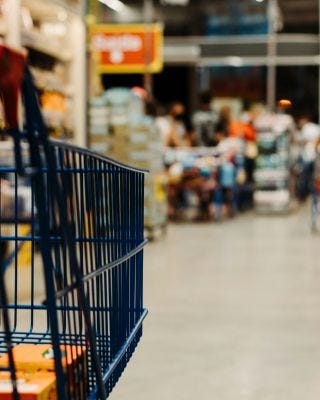1 Week, 7 Stories #54
Things are looking up. Not always good news if it is grocery prices, microplastics, or border tensions.
Every edition features 7 stories from the past week. I’ll draw on my background in media, journalism, agriculture, biotech, and renewable energy to come up with an interesting selection and to offer some context.
As the holiday season approaches food and grocery shopping becomes top of mind. However the rising cost of food has been top of mind for a couple of years now, so lets reach into the shopping cart and take a peek.

First off, grocery prices and the rising cost of your weekly food bill is not a local, regional, or national problem. As The Guardian put it, wake up and smell the coffee – it is global.
In October, food commodity prices were at the highest since April of 2023. That is a global statistic from the United Nations Food and Agriculture Organization. Vegetable oil prices were up a whopping 24%, the dairy category 17%, meat 10%. It will vary locally or regionally, but the bottom line is we are not alone. Canada is not exactly known for producing palm oil so if you buy something with palm oil, guess what – it costs more. We can produce seasonal peaks of some produce but in the dead of a Canadian winter your tomatoes and strawberries come from away.
Canada’s Food Price Report for 2025 is out this month and it predicts prices will continue to climb between 3 and 5 percent. About an extra $801 over this year. The report is led by Dalhousie University and has a good track record for accuracy. A Dalhousie University media release points out that global weather patterns, geopolitical conflicts, energy costs, currency fluctuations, government policies, and regulations affect prices everywhere along the chain. Seafood arriving in landlocked Alberta, bananas in the middle of an ice storm in Quebec, and oranges from California or Spain making it in time for Christmas in the Maritimes are all part of a global growing, processing, and distribution landscape.
Politicians cannot promise to lower your food bill, or the cost of food for the 29% of Canadians living with food insecurity. It seems the best we can do right now is help those that need it the most and rely on policy makers to make a dent in our overall cost of living.
As for smelling the coffee when you wake up, we are facing record high coffee prices so enjoy it while you can afford it.
The number of ways we can cut harmful emissions seems to look better every year with new technology and some innovative thinking. Biofuels are seen as one way to replace fossil fuels in some situations, but the idea is not exactly brand new. Animal and vegetable oils for lamps date back to ancient civilizations and Rudolf Diesel’s first diesel engine was powered by a vegetable oil fuel.
The latest development in biofuels is another step to increasing its use and its fuel efficiency which has been one of the drawbacks. According to a news release from King’s College London, research on a new way to produce biofuel “from chip shop to pit stop”, is 1000-times more efficient than current methods. The research was published in the journal Green Chemistry and promises the production technique will produce a fuel that is the chemical equivalent of fossil fuels without additives or blending.
The International Energy Agency predicts that between 2023 and 2028 biofuel demand will grow by 38 billion litres to hit 200 billion by 2028. The agency says that efficiency requirements, higher costs, and technical limitations are holding back growth. If this new research can be applied at an industrial level, we can expect the supply and demand to increase even more.
The lingering problem is still a sustainable feedstock for all types of biofuels. Maybe along with our green, blue, and black carts for municipal pickup, we’ll have one for our leftover cooking oil!

There are more than enough hotspots around the world with the potential for simmering tensions to boil over. One you might want to keep an eye on is the Republic of Estonia. It sits on the Baltic Sea with a 294 km (183 mi) border with Russia and a 333 km (207 mi) Latvian border.
It is that Russian strip worth noting.
Much like the strained Ukraine – Russia tensions that led up to the current conflict, Estonia and Russia have not had a happy history with Russia occupying Estonia for much of the 20th century. On the heels of the country’s “Singing Revolution”, Estonia gained its independence in 1991. It joined NATO in 2004 which may account for it having not yet met the same fate of Ukraine. Estonia spends more that 3% of its GDP on defence and starting last week British, French, Latvian, American and Estonian troops have been conducting a joint exercise in Estonia called operation Pikne (meaning lightning). The UK, France, and Iceland have a permanent military presence because as the New York Times reported in January, a NATO – Russia conflict is no longer unthinkable and for Estonians, it is “only a question of when”.
The political tensions were on display at a meeting of the Organization for Security and Cooperation in Europe ministerial meeting last week. It started as Russia’s Foreign Minister Sergey Lavrov approached the podium and the foreign ministers from Ukraine, Poland, and Estonia walked out. Estonia’s ambassador to NATO said Russia does not want any negotiations to end its war with Ukraine.
Estonia is a major supporter of the Ukrainian war effort, and in an attempt to enforce EU sanctions against Russia instituted full road and rail border control on traffic coming from Russia in August. Within a month customs authorities said there were 600 violations. It has been increasing its border security with wire fencing and enhanced surveillance and radar monitoring. In May the government recommended against any travel from Estonia into Russia.
Diplomatic relations between the 2 countries have been a tit-for-tat since early 2023 when each expelled the other’s diplomats. Russia has since ordered the closure of the consulates of Latvia, Estonia, and Lithuania in St. Peterburg and all employees are labelled as persona non grata.
In February of this year Russia added then Estonian Prime Minister Kaja Kallas to its wanted list “over the destruction of monuments to Soviet soldiers”. Also added were Lithuanian Culture Minister Simonas Kairys and Estonian State Secretary Taimar Peterkop.
Find a good map of the Estonia – Russia border and keep an eye on the news over the coming year.
We are running low on blood. Not me or you personally, but around the world there are not enough donors to meet the blood product demand for a growing and aging population. In Canada, only 80% of the available appointments needed to meet demand are filled, leaving a gap at critical times. Globally, 61% of countries have chronic blood shortages which has prompted years of research and development into synthetic blood products that mimic hemoglobin-based oxygen carriers (HBOCs).
One of the latest ideas comes from a team of students at the University of Calgary who are taking hemoglobin from earthworms to the next level. As weird as it might first sound, earthworms are high in erythrocruorins which are large oxygen-carrying proteins making them a perfect blood substitute candidate. The U of C students won several medals at November’s iGEM (International Genetically Engineered Machine) Grand Jamboree in Paris for their work on synthesizing worm HBOC using a lab grown yeast system to reproduce the key properties. The team also won the Best Entrepreneurship Special Award and the Safety and Security Special Award. They were up against 400 teams from 50 countries presenting synthetic biology projects. Consider iGEM as a science fair on steroids using the latest high-level concepts in synthetic biology to address real-world problems beginning with experiments and ending with proof-of-concept and start-up companies.
The U of C team feels that with further research and testing they can lay the groundwork for large-scale sustainable production of HBOC to address the problem of blood shortages.
There was enough going on up beyond the earth this week to warrant another Space News section.
Blue Origin is a commercial company founded by Amazon’s Jeff Bezos in 2000, with its sights set on the wild blue yonder. It launched its first uncrewed mission in 2015 and has since completed 9 crewed launches. Reporting from TechCrunch says the company’s New Glenn launch vehicle (named after astronaut John Glenn) is set for a ‘hot fire’ test this month. If that test is successful the next step for the will be a liftoff from Cape Canaveral according to a Blue Origin media release this week. That launch is key to for the rocket to earn National Security Space Launch certification so it can enter into contracts with the US Space Force. The 98 metre (320 feet) tall rocket is designed to carry 45 metric tons (99,200 pounds) to low Earth orbit.
Also this week the Breaking Defense website reported that United Launch Alliance said it expects to receive certification for its Vulcan vehicle to carry Space Force payloads soon, though the CEO admits that ‘soon’ is a flexible target. United Launch Alliance is a joint venture of Lockheed Martin Space and Boeing Defense, Space & Security. According to the Breaking Defense story the company hopes for 20 to 30 Vulcan launches per year with about half for national security missions.
SpinLaunch is a company with a completely different approach to getting payloads into space. Looking like something you might see on the cover of an old Tom Swift book, SpinLaunch uses what amounts to a giant high tech, electric slingshot to hurl up to 200 kilograms (400 pounds) into space. Inside its vacuum chamber the payload is spun around at upwards of 8,000 kph (5,000 mph) before being shot into space. (Gizmodo said it spins the “living crap” out of a satellite) That creates a tremendous G-force on the payload and the company made space news this week with a successful test which demonstrated that a small satellite can hold up under that extreme acceleration. The unique launch system has yet to be tested with an orbital launch. Earlier this month SpinLaunch closed an $11.5 million funding round though some reports said it had hoped for much more.
And as an fyi, 52 years ago this week the crew from the Apollo17 mission were the last people to walk on the moon. Don’t expect anyone to repeat the feat until sometime in 2027.
Not quite so high in the sky, the International Air Transport Association (IATA) said in a media release this week that business in the past year and into 2025 is looking better after a few dismal years. Depending on which sector you’re interested in, there were a couple of high notes. Travel and Tour World focused on global passenger traffic which increased 7.1 % from the previous year with the greatest percentage coming from international travel. The International Airport Review dived into air cargo demand which was up 9.8%. One of the low notes was in the growth of sustainable aviation fuel production which is behind projections.
Airlines themselves are expected to see considerably higher revenues in 2025 and may break the one trillion-dollar mark for the first time. Apart from higher passenger volume adding to the bottom-line, higher airfares, those irritating extra charges, lower fuel prices, and increased aircraft efficiency have helped the outlook.
Never one to miss the chance of a pun, there is some turbulence ahead on the profitability flight path. Boeing and Airbus are behind in their deliveries which cuts into those efficiency savings through increased costs for airlines to maintain and fly older aircraft. Global supply chain problems are adding to the problems. The world’s geopolitical conflicts are also getting in the way as some routes must be abandoned or changed because of the Middle East and Russia-Ukraine conflicts. Some pilots and unions expressed their concerns this week about Middle East routes in particular.
You can see the full report on the IATA website.
Microplastics are not new to regular readers of this newsletter, but this edition has an update on mitigating the microplastic problem.
Chinese researchers have developed a sponge made of cotton and squid bone that absorbed about 99.9% of the microplastics from water samples. While it does not address the root cause of plastic pollution, The Guardian says it could change the course of the public health problem posed by microplastic. The researchers have published their findings in the peer-reviewed journal AAAS Science Advances.
There is little doubt that we need to control microplastics which are the small bits of plastic that come from the breakdown of consumer plastic products. They pollute our environment and end up in our bodies, including our brain which have been found to contain microplastics. In one study from 2022, researchers found microplastic in the blood of 77% of the people tested.
This new sponge is not the first one developed by Chinese researchers. Last year a different research team said they had made a sponge from starch and gelatin which Smithsonian Magazine said looked like a “large white marshmallow”. That sponge could be used in wastewater treatment plants to filter out microplastics before it makes it any further into the environment, or a smaller sponge to be used in your washing machine.
Both of these sponges are still in the experimental stage and could be scaled up for industrial use, but there are challenges. Starch and gelatin are important to the food industry and a scaling up of that sponge tech would result in competition for the resources. The one which relies on the bones from squid would also seem to face some resource limitations.
Simply boiling water can remove a significant amount of microplastics but that is not practical on an industrial scale. Also being studied to remove harmful nano and micro plastics are membrane filters, oxidation, and biodegradation.
Best bet however is to recycle your plastic and improve how we handle plastic to keep it out of our environment. Or simply use less of it.
-
Read, comment, subscribe, and share this newsletter.
I’m available for contract and freelance work with not-for-profits and charities. With 40 years of experience behind me and lots of time ahead of me, I’m here to help you make a difference in your media relations, public relations, and general communications needs.


